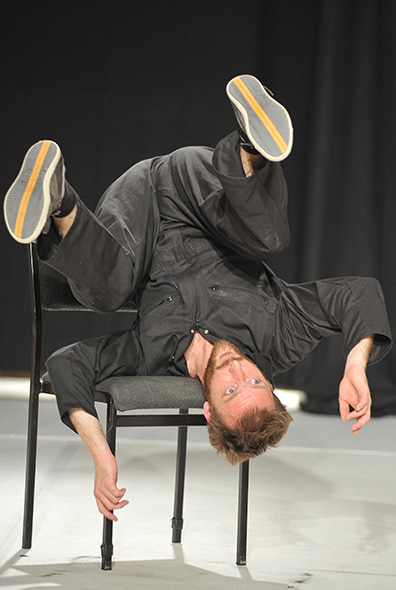
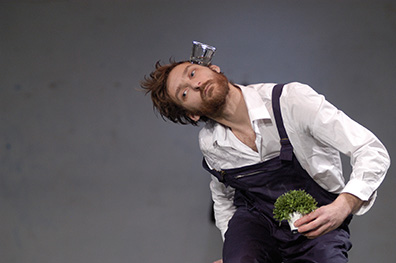
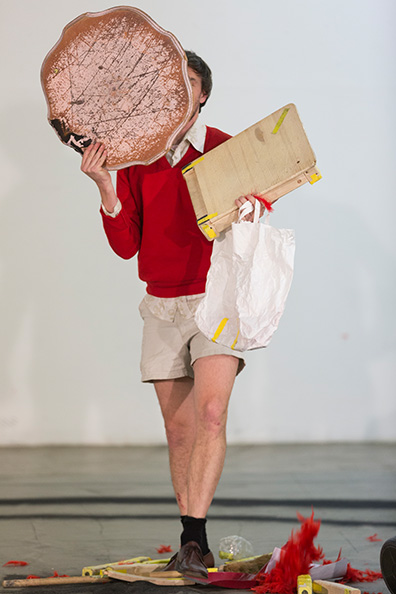
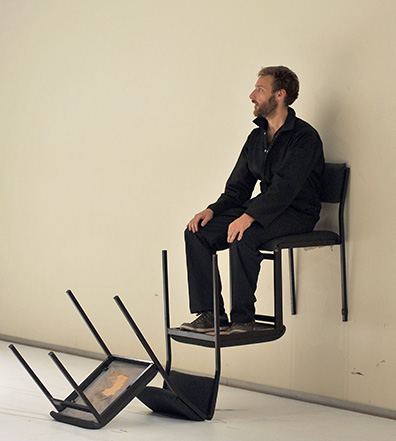
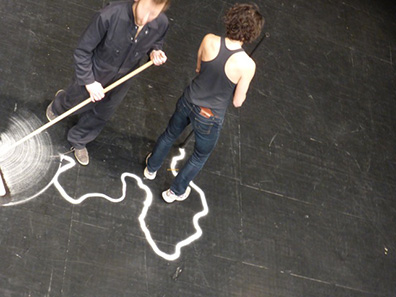
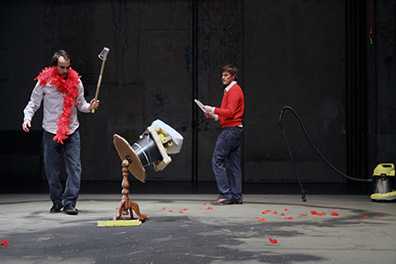

the secret life of things
Clement Layes
Sep 14 – Sep 25, 2015
Objects, things in front of us, behind us, above us, under, inside, their presence defines us, making our knees bend to climb, making our arms stretch to catch, our back curve to focus, our jaw close to bite. The stairs, the glass, the book, the apple, those simple elements of our daily life define us as much as we define them. This elementary dialogue: the object I choose, the way it makes me move, will be our ground, the point zero of our study of performance. In this primary relation that we all experience on a daily basis, lies a complex and diverse system of organization, ideas, thoughts and prejudices. Hidden behind these simple things are huge manufactories, workers, marketing strategies, technological devises, visions, and the entire human choreography is there waiting to be acknowledged. How to perform on a stage with those companions and their implications?
Floating above the ground of things, the cloud of words, the language, in its use and misuse, is imbricated into our daily frameworks. Language - in its relation to the basis of all things - constitutes for us what we will call the "key of dreams", referring to the various ways, from antiquity to modernity, in which the appearance of things in dreams can be interpreted. It is this gap between the words and the things, this tension, which we will explore. We will examine it carefully to discover what those light bubbles or solid aggregates are that make the relationship between an audience and a performance possible and hopefully interesting. To enter this secret life of things, this gap between them and our knowledge, we will need to prepare ourselves carefully. In order to be focused and available, loose and sharp, we will enter the following plan:
1. What comes easily
2. What is difficult
3. What can be said
4. What cannot be said
What comes easily is the patterns of movement and thoughts which come naturally to us. We'll explore this pleasurable and comfortable area of non-judgmental practices, letting interest arise from what comes, in free association, in authentic movement, but mostly through exploring the multiple possibilities of objects, their functions and dysfunctions. Something we could call humorously the "authentic object". What are the simple and practical use of things? How do they imply movement? What can they do? What are the easy ways to move them? How do they inform my body of their specificity? Not to personify or represent objects like object-theater does, but to objectify them even more, to explore their radical otherness, a sort of phenomenological approach of things through the body, by asking repetitively: what is it? How does it move? We'll aim to loose the centrality of the subject, the mastery of the human body over the things by loosing ourselves into them. Like kids in games, letting ourselves react and be driven by what comes easily with no goal other than the path of the experience.
What is difficult is a series of goals-orientated exercises that require practical training, leading towards improvement, exploring both how we move objects and how we move on objects. We will study the various skills to achieve a certain mastery over them, we will find and develop techniques to use and misuse objects. I'll propose some exercises, on which we will expand upon in order to create one's own personal exercises. The various exercises will reinforce our center, practice balance, sustain attention, improve speed, develop understandings of mechanics and dynamics in relation to objects, and reinforce our trust in our reflexes to face unexpected situations without panic, unexpected situations which are bound to happen when performing with things.
What can be said is the verbal counterpart to the free flow of the "authentic object", it is a collective practice, similiar to free-associative games of language, where the collective ideas, knowledge, projection and fantasies about certain objects of our choice unfolds. Drifting in a light collective trance we'll discover in the objects the bribes of stories, the floating associations, the tension of desire. We'll negotiate with and against the alterity of the thing at stake, it's reality, it's virtuality, and it's potentialities.
What cannot be said is the final step of our preparation before starting the study of the “key of dream” to enter the secret life of things. It's a moment where silence and concentration are required, to let arise what cannot be said. The shadow, the unknown, the blank areas, the white walls, the black holes, the unspoken, all which constitutes the grey area of any objects. It's the act of opening the curtains of perception to see the singularities - chairs, table, computer, pictures, bag - which we are defining ourselves in relation to.
The key of dream
At this point we'll be able to start the actual study of the key of dream, where we'll introduce the position of the viewer, which we'll call the public. We will study it in its most elementary level: what happens in this relationship of watching-doing? The object at stake is not anymore this certain sofa, this precise trash bag or cup, but for the audience the performance, and for the performer the attention of the audience. We'll define tools for understanding what works, and why. What does the public follow? Where and how is our attention led? Is it towards this precise point in space or towards this enigmatic phenomenon unfolding in front of me? What images, associations or thoughts is this producing?
In performance mode, when we have previously defined the possible gestures for an object and the possible words for the same object, all that remains to perform is composition, rhythm, and a range of ways to perform that simple task.
We will make this simple task more complex by accumulating objects and words, creating a gigantic mechanism in which we'll explore the relation between object and object, language and objects. A mechanism will be composed of the previously built-up grammar
and we will play in it together with this developed vocabulary and our shared knowledge. In this on-going construction we will observe where and when the key opens the door to the secret life of things, if ever.
But defining, clarifying and constructing through experience and feedback is only one aspect of the study of performing things. As the key lies in between language and things, un-defining and blurring are the last but most liberating stages of this study. Alone or in a group, for ourselves and others, without aiming
for success or expecting comments we will make attempts toward this disturbing instance that defies language and recognition, and which we should therefore renounce its categorization as art, dance, or performance.
––––––––––––––––––––––––––––––––––––––––––––––––––––––––
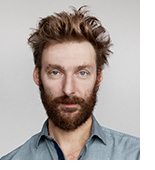 Clément Layes has been living and working as a choreographer and performer in Berlin since 2008. Here, he co-founded the company ‘Public in Private’ with Jasna Vinovrski. At the interface between choreography, visual arts and philosophy, the point of departure of his works is found in observations on daily life. His performances – among them “Allege” (2010), “Der Grüne Stuhl” (2012) and “Things That Surround Us” (2012) – are shown internationally. His latest piece “Dreamed Apparatus” was premiered in April 2014 in Berlin. He studied art and philosophy, then graduated in dance at the CNSMD (Conservatoire National Superior de Musique et de Danse de Lyon). He performed various choreographies in the "Jeune Ballet" (Dominique Bagouet, Yuval Pick etc.) and after joined Boris Charmatz for a year long research group project, a nomadic and temporary academy. During this experience he encountered among others artists and practitioners: Hubert Godard, Jean Luc Moulène, Vera Montero, Claude Espinassier, Steve Paxton, Joseph Nadj, Joris Lacoste…whom helped him toward the invention of his own practice.
Clément Layes has been living and working as a choreographer and performer in Berlin since 2008. Here, he co-founded the company ‘Public in Private’ with Jasna Vinovrski. At the interface between choreography, visual arts and philosophy, the point of departure of his works is found in observations on daily life. His performances – among them “Allege” (2010), “Der Grüne Stuhl” (2012) and “Things That Surround Us” (2012) – are shown internationally. His latest piece “Dreamed Apparatus” was premiered in April 2014 in Berlin. He studied art and philosophy, then graduated in dance at the CNSMD (Conservatoire National Superior de Musique et de Danse de Lyon). He performed various choreographies in the "Jeune Ballet" (Dominique Bagouet, Yuval Pick etc.) and after joined Boris Charmatz for a year long research group project, a nomadic and temporary academy. During this experience he encountered among others artists and practitioners: Hubert Godard, Jean Luc Moulène, Vera Montero, Claude Espinassier, Steve Paxton, Joseph Nadj, Joris Lacoste…whom helped him toward the invention of his own practice.
––––––––––––––––––––––––––––––––––––––––––––––––––––––––
photos:
Trevor Good
Dieter Hartwig
public in private
G.F.Ludiwg
Doro Tuch
